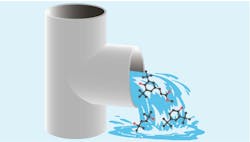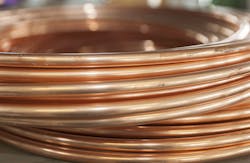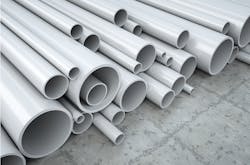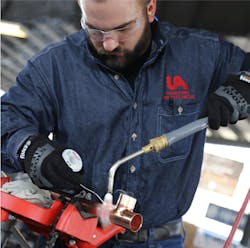Reducing Water Quality Concerns within Critical Patient Occupied Facilities
By ANDREW G. KIRETA Jr., Copper Development Association
From the nationwide lead piping issue brought to light by the crises in Flint and Newark, to extensive chemical contamination caused by plastic systems, it’s clear that piping material decisions impact the health and safety of building occupants.
These concerns are especially important to consider as construction and renovation of critical patient occupancy facilities increases. By 2020, approximately 17 percent of the nation will exceed the age of 65. The increasingly large group of seniors will require new medical space to accommodate their health needs.
To defend against potential health and safety risks, it’s crucial to select materials that reduce threats to water quality from leaching, permeation, and fire hazards.
Leaching
Chemical leaching has been an active media topic recently, and for good reason; a 2018 study originally published in Environmental Science & Engineering found 163 different substances leach from the six plastic polymers: polypropylene (PP), polyethylene (PE), cross-linked polyethylene (PEX), high-density polyethylene (HDPE), polyvinyl chloride (PVC), and chlorinated polyvinyl chloride (CPVC). Many of these substances are carcinogens or toxins that diminish reproductive and overall health; nearly half (74) aren’t even regulated or their effects on human health are unknown.
Copper, an historically-proven safe piping material, doesn’t leach chemicals. It’s made up of 99.9 per-cent pure copper and a small amount of phosphorous. While water sources with a low pH (a high acidity) or very high alkalinity may trigger copper leaching, only 2 - 5 percent of water supplies possess this trait and there are proven mitigation solutions for this situation.
Among its many benefits, copper simply does not leach chemicals.
For the majority of people, copper is a daily nutrient critical for human health. Every day many consume cop-per without even realizing it; common sources include shellfish, dark chocolate, whole grains and almonds. The body needs copper to maintain blood health and muscle strength, especially for the heart’s elasticity.
Although it is possible to have too much copper, this is unlikely. Copper is only a concern for individuals suffering from Wilson’s Disease, a genetic disorder affecting 1 in 30,000 Americans. This disease prevents the body from correctly processing and regulating copper.
For these reasons, the limit for copper is extremely high under the Environmental Protection Agency’s Lead and Copper Rule at 1,300 parts-per-billion (ppb). By contrast, the limit for lead – an established, well-known neurotoxin– is 15 ppb. On any given day in the United States, the copper concentration of a drinking water supply ranges from 20 – 75 ppb.
Permeation
The possibility of contaminants around a pipe penetrating the material and mixing with the clean water inside also poses a risk to health, especially for pipes near gas stations, driveways, roadways, or where pesticides are sprayed.
Flammable and permeable, plastic may also allow harmful substances to contaminate water.
Significant research (includ-ing studies in 1991, 2006, 2010, and 2015) has reinforced the conclusion that plastic may allow harmful substances, including gasoline, chemicals and organic matter to contaminate water. On the other hand, such materials will not permeate through copper. This is a major point of differentiation from plastic, which is why copper is use for a variety of installations, from service lines to in-building systems.
Fire Safety
Since piping materials are often hidden out of sight in the walls, under the floor and in the ceiling, they may connect adjacent building zones. If a flammable material such as plastic is used for pipes, fires can use it as a conduit, helping move flames from one area to another.
Copper and other metal pipes will not melt, burn, give off toxic fumes, or contribute to the spread of fire. Its high melting point prevents it from igniting.
For these reasons, the International Association of Fire Fighters (IAFF) and the United Association of Plumbers, Fitters, Welders and HAC Service Technicians (UA) recently called for a ban on plastic piping in hospitals, nursing facilities, high-rise residential structure, and health-care centers. Understandably, plastics are a concern to firefighters and other first responders who may breathe in the toxic fumes emitted by burning plastic. Plastic pipes that burn also may impact building owners by tainting water supplies.
“Just as firefighters have always been there to protect us in emergencies, the plumbers and pipefitters have been quietly and successfully protecting the health and safety of the nation for almost 100 years,” UA General President Mark McManus said in a press release distributed by IAFF. “There are plenty of safe, sustainable and recyclable materials available today that don’t pose health risks to workers or the public. This initiative is about choosing the safest and most durable option in product selection.”
UA: Plumbers and pipefitters also protect public health, safety.
An example of this can be seen in this year’s deadly Paradise CA wildfires. After plastic systems were degraded by the fire and high heat in several areas, they released the carcinogen benzene and other toxins into the water system. These contaminants then traveled throughout the water distribution network and poisoned the water of areas that never even burned. The city now estimates its water won’t be drinkable for another 2.5 years and may cost $300 mil-lion to replace. A similar situation occurred in Santa Rosa CA, after the 2017 Tubbs Fire, which burned 36,807 acres and destroyed 5,636 structures.
An investigation by the city and the water department, found that “…Benzene and other hydrocarbons detected in the water system in the advisory area originated when plastic components of the system melted during the fires.” They further found this fire damage, “…allowed a combination of benzene, superheated air, ash and debris to enter the main water delivery pipes.”
Using Copper to Ensure Water Quality
Material selection is not a simple process. Decision makers should consider what is more valuable: decades of safe, healthy drinking water, or value engineering to save a small amount of money during installation. They must select materials, like copper, that offer the highest defense against threats from leaching, permeation and fires.
Based in Indianapolis, the author is vice president of the Copper Development Association Inc. (CDA), responsible for educating the market on use of copper and copper alloy systems and products in building construction applications, including plumbing, mechanical and architectural systems. For more, visit www.copper.org.




